TOURING MODERNISM
As problems persist I decided to create a new website for this MOOC- http://idabrandao.wixsite.com/mooc-modernism

14 July 2016
Something very wrong happened today, the system deleted my webpage. I was posting on session 4. Now I’ll try to recall and copy my posts from the course – https://www.kadenze.com/courses/touring-modernism-from-the-french-avant-garde-to-american-pop-and-beyond-i
The course started on the 26th of May 2016, promoted by the School of the Arts of the Institute of Chicago, in platform Kadenze.
The Syllabus:
Session 1: The Rallying Cry of the Avant-Garde (May 26, 2016)
Romanticism and Realism
Session 2: The Power of Form and Emotion of Color (June 10, 2016)
Impressionism and Post Impressionism
Fauvism and Cubism
Kandinsky, Mondrian, And Malevich
Dada Breaks the Mold
Courting the Unconcious
The heroics of the New York School
The New York school and Abstract Expressionism
Pop art
Minimalism
Earthworks, Body, and Conceptual Art
Postmodernism and beyond
German Expressionism evolves between 1910 and 1930 and reflects in different cultural fields – in architecture, in dance, in painting, in sculpture and in film.
WWI had a tremendous impact in art and post-war defeated Germany, with the horrible casualties, showed this dark side through art. Many artists turn to printmaking which allows a more democratic distribution of accessible art and the prevailing «black and white» of most prints serve the intensity and tension of Expressionism.
Otto Dix prints horrific scenes of war are an example 
as Käthe Kolvitz prints, with its leit motiv of morning mothers and children – http://www.wikiart.org/en/kathe-kollwitz/not_detected_235978?utm_source=returned&utm_medium=referral&utm_campaign=referral

Two groups become important within German Expressionism movement: Die Brücke and Der Blaue Reiter, named after one of Kandinsky’s paintings. They held a common position «in reaction to the dehumanizing effect of industrialization and the growth of cities» and they distance themselves from traditions and institutions, rejecting realism and the bourgeois society. They want to express the subjective emotions of people.
Ernst Ludwig Kirchner is one of the founders of Die Brücke. This painting of Nollendorfplatz shows some of the characteristics of the Expressionism, with intense colours and exaggerated distorted perspectives.

Wassily Kandinsky’s painting Der Blaue Reiter names the movement – 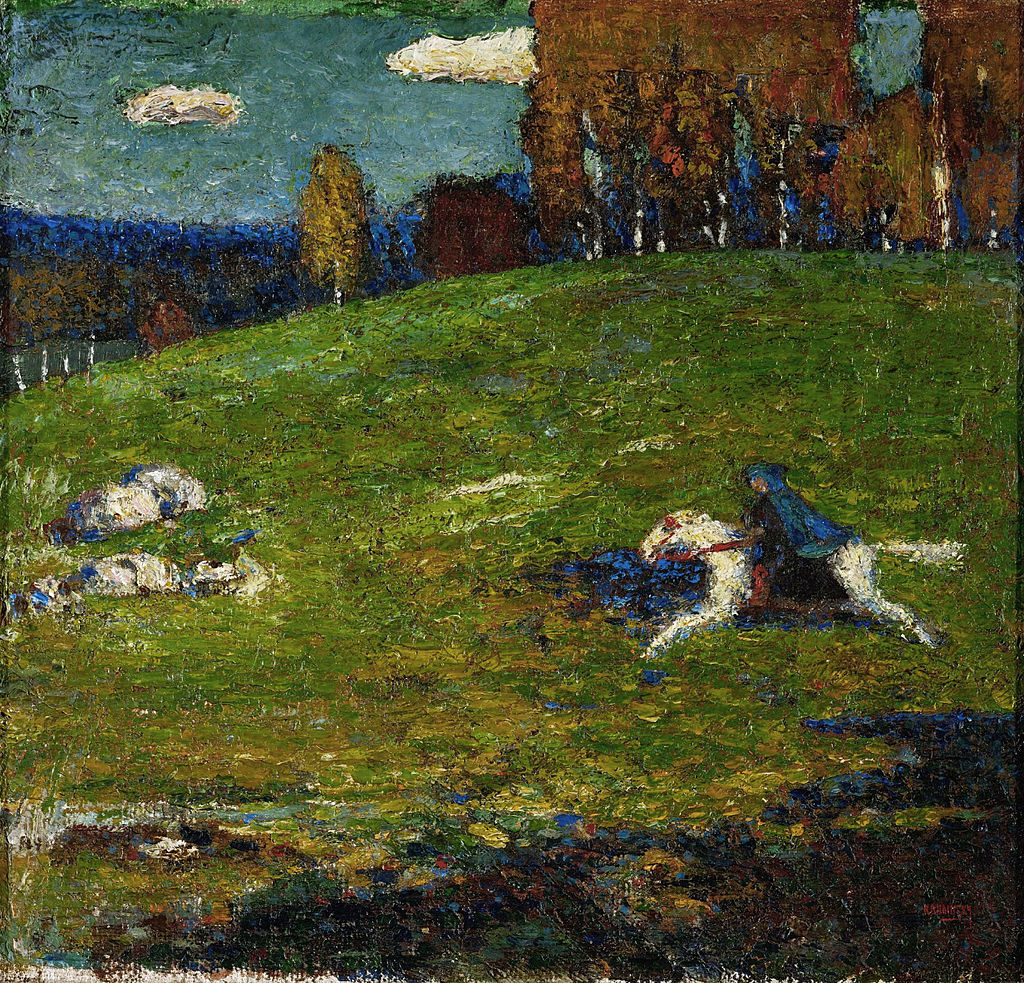 Kandinsky’s most famous paintings will evolve towards much more abstract and geometric forms, closer to constructivism and suprematism.
Kandinsky’s most famous paintings will evolve towards much more abstract and geometric forms, closer to constructivism and suprematism.

Later on, he will be a major figure in another important German movement Bauhaus.
The intensive and dark side of Expressionism influences horror movies and other intense works of the 20’s and 30’s. In the video presentations was referred The Cabinet of Dr. Caligary which reproduces the strange chaotic perspectives of certain expressionist paintings. The whole movie is available in Youtube, here is the trailer –
The master piece of the silent horror movie is Murnau’s Nosferatu
However, other master pieces of Russian film are the perfect example of Expressionism, such as Eisenstein’s movies
and the amazing Dziga Vertov’s documentary Man with a Movie Camera
Arnold Shoenberg is one of the first musicians to distance from classic music (though he admired Beethoven and many other) towards a disruptive sound and atonality
Stravinsky revolutionary music sounds very different with its rhythmic energy. Diaghilev’s Ballets Russes are a success and modern expression of the movement
Expressionism in Poetry – http://www.textetc.com/modernist/expressionism.html
«The movement drew on Rimbaud and Nietzsche, and was best represented by German poetry of the 1910-20 period. Benn, Becher, Heym, Lasker-Schüler, Stadler, Stramm, Schnack and Werfel are its characteristic proponents, though Trakl is the best known to English readers.
Like most movements, there was little of a manifesto, or consensus of beliefs and programmes. Many German poets were distrustful of contemporary society — particularly its commercial and capitalist attitudes — though others again saw technology as the escape from a perceived “crisis in the old order”. Expressionism was very heterogeneous, touching base with Imagism, Vorticism, Futurism, Dadaism and early Surrealism, many of which crop up in English, French, Russian and Italian poetry of the period. Political attitudes tended to the revolutionary, and technique was overtly experimental. Nonetheless, for all the images of death and destruction, sometimes mixed with messianic utopianism, there was also a tone of resignation, a sadness of “the evening lands” as Spengler called them. »
Imagism and Vorticism were poetry movements coined by Ezra Pound, who was a reference, at the time, by many other great poets like T.S.Eliot or William Carlos Williams.
Futurism had its own Manifesto with the leadership of Marinetti
Dada Movement spread from Europe, Duchamps, to NY with Tristan Tzara and was expressed in poetry like the ones of «crazy, scandalous» Baroness Elsa – A dozen Cocktails, please – http://www.writing.upenn.edu/~afilreis/88v/dozen.html, written during prohibition times. It took a century for her poems to be published –

Expressionism and Rebellion – https://pages.gseis.ucla.edu/faculty/kellner/Bronner_Kellner.pdf
http://germanexpressionism.net/
Expressionism – http://www.saylor.org/site/wp-content/uploads/2012/02/ARTH208-3.4.1-Expressionism.pdf
The influence of German Expressionism on the films of Fritz Lang and Robert Wiene –https://news.artnet.com/market/art-house-an-introduction-to-german-expressionist-films-32845
German Expressionism – http://www.visual-arts-cork.com/history-of-art/german-expressionism.htm
Expressionism in the theatre – http://assets.cambridge.org/97805212/27391/excerpt/9780521227391_excerpt.pdf
As I’m a fan of Tim Burton’s films: How Expressionism influenced Tim Burton: a video essay – http://www.openculture.com/2015/06/how-german-expressionism-influenced-tim-burton-a-video-essay.html
German Expressionism: Nightmares in the Golden Era 1919-1926 – https://www.academia.edu/10605770/German_Expressionism_Nightmares_In_The_Golden_Era_1919-1926
Almada Negreiros (1893-1970) was an ecletic intelectual, a multidisciplinary artist who introduced futurism and is the central icon of portuguese modernism. He has no academic background but he is a great talent and a strong personality, extremely disruptive either as a painter or as a writer.
https://en.wikipedia.org/wiki/José_de_Almada_Negreiros
He also went to Paris and contacted many of the modern artists of the early modernist generation, but he believed that art required a homeland context. His work is quite impressive with the famous mosaic panels of the maritime station in Lisbon
A detail with the typical traditional fish vendors 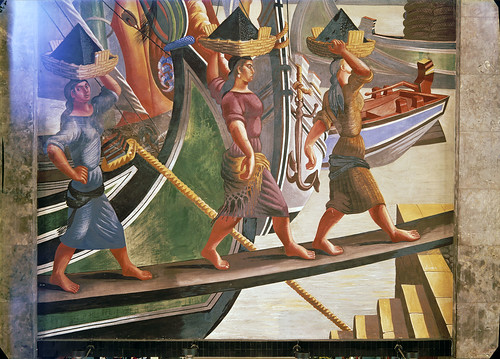
The famous portrait of modernist poet Fernando pessoa
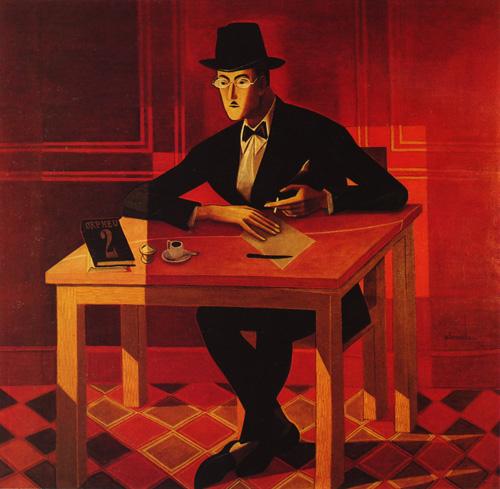
There’s a famous cubist painting, named Head, by Santa Rita, inspired by african masks, as modern primitivists admired, and with curve movement lines as the futurists liked (Boccioni sculptures).
Santa Rita was a friend of other portuguese modernists like Amadeo and Almada, but as Amadeo he also died young, at 29, victim of tuberculosis, and as a dying wish determined that all his paintings should be destroyed, so there are only a few drawings that he published in the poetry magazine Orpheu and this «Head» and nothing else survived. He was one of the leaders of Futurism in Portugal and this is one of his «cool» photos in an extravagant outfit.

Portugal was much influenced by French art and some painters and poets had life experiences in Paris in the beginning of the 20th century. One of those painters was Amadeo de Souza-Cardoso, who died young in 1917, at 30, of the epidemic spanish flu. He remained unknown and his work was undervalued for many decades. As he was ill for a long period at his family’s home, he painted a lot, but it seems that his family didn’t value his work and many paintings were destroyed by fire after his death.
He gets acquainted with Modigliani, Brancusi and Archipenko and, later on, with the couple Delaunay and through them with other famous artists and poets like Apollinaire, Picabia, Chagall, Boccioni, Klee, etc.
Amadeo exhibits also in the Armory Show, in NY, in 1913 and in Berlin Erster Deutscher Herbstsalon , with the italian futurists and Blaue Reiter movement.
As many other artists of the time he made collage.
Avant la Corrida, 1912


Session 3 introduced 20th century modernism with Fauvism and a set of painters who focused on the power of form, a certain primitivism, wild strokes and vibrant colours. Les Fauves stand for «wild bests» and their leaders were Dérain and Matisse.
Matisse self-portrait (1909) and Dérain self-portrait (1903) show those features of strong strokes and colours
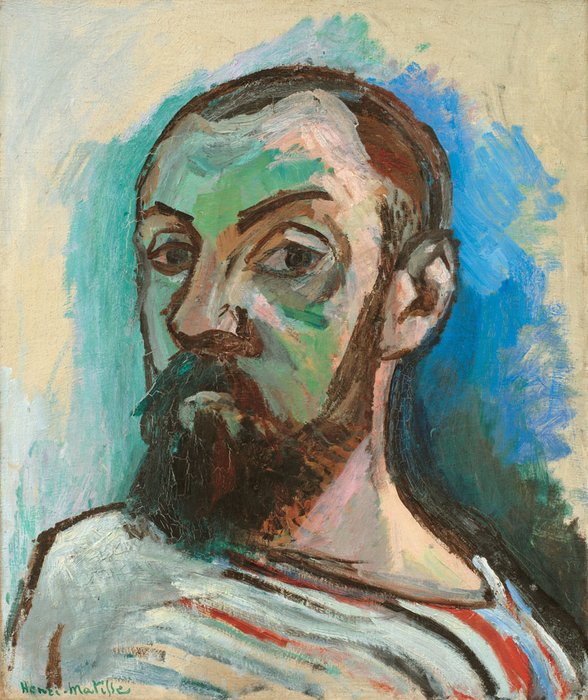

I think nobody gets indifferent before a Turner’s painting, the power of the elements of nature and the light.
He started painting early in his life, encouraged by his father, a barber, who would exhibit his son’s drawings on his shopwindow.
He lives a long and successful life as a professional painter, who joins the academy, and lives on good commissions.
He also travels a lot through England and later on to Europe, France, Swiss, Italy and Venice. He sketches all over the places and he left a collection of over 19 thousand sketches. As a traveller he painted a lot of watercolours.
His paintings evolve from a more figurative to an almost abstract painting, where colour and light reigns. He is a master of atmosphere and his paintings convey much emotion and are very dramatic, namely on scenes of storm at sea or other powerful manifestations of nature.
He was very secretive about his life, both on his paint method as on his personal relationships, probably owing to his mother’s madness, who is institutionalized. He himself has a morbid and depressive character, showing some irritability. He was not a likeable person. Delacroix gets acquainted with him and has no great opinion of his person.
His later more abstract works bring out some criticism and negative critique. Considered a romantic, I find some of his paintings really modern and ahead of his time.
A great english documentary on Turner –
Turner’s watercolour at 15 years old

His first oil painting exhibited at the Royal Academy, at 21 years old

A later painting Sunrise and Monsters

Gaudi is also a phenomenon of the turn of 19th to 20th century. There’s a certain mysticism and ascetic feature in his architecture of a modern neo-gothic, namely in his Sagrada Familia. There are many elements of Art Nouveau in the decor of his buildings, and he was also a designer of furniture and other pieces. The use of broken mosaic in Sagrada Familia and Parc Guell is very original.
My first visit to Barcelona, some decades ago, was determined by my passion for Gaudi, at the time. I’m not particularly enthusiastic of certain aspects of his personal life, namely his links to the Church which was extremely reactionary, but I confess I am an admirer of his work. There’s a sense of sculpture in his organic architecture that delights me.
I’m also attracted to this organic feature in Frank Gehri buildings. A few years ago I went to Bilbao just to visit the Guggenheim Museum, which has a great webpage – http://www.guggenheim-bilbao.es/el-edificio/
It is great that contemporary sculpturs are so different such as Rodin and Brancusi. While Rodin is mostly figurative and the human body is so full of expression and emotion, Brancusi works on pure abstract forms. His Bird in Space of 1928 is a good example. The pedestals are also important in his sculptures, some would turn, so that viewers might have dfferent perspectives of the piece. He was skilled with many materials.
An interpretation of Mlle. Pogani
The video refers to the bad critique reviews that were made to this sculptur at the time of its exhibition, as was Duchamps’ painting Nude Descending a Staircase – https://en.wikipedia.org/wiki/Nude_Descending_a_Staircase,_No._2. An american contemporary poem by X.J.Kennedy to this painting
Many years ago, I took a week holiday in Paris to devote to visit museums. Rodin Museum was one of them that I recall vividly, because I was impressed with the amount of plaster and clay models. His sculpturs are well known but some were a surprise for me, at the time, namely the Bourgeois of Calais, which is outside the House Museum – http://www.musee-rodin.fr/en/collections/sculptures/burghers-calais-first-maquette
The interpretation of Rodin’s never ending work Gates of Hell – https://www.khanacademy.org/humanities/becoming-modern/avant-garde-france/avant-garde-sculpture/v/rodin-the-gates-of-hell-1880-1917
A BBC documentary on Rodin –
A wonderful ballad from the 70’s by Don McLean with great lyrics, a wonderful tribute to Van Gogh’s paintings
Recently, I was making a school resource on the classification of clouds – a handicraft book with sliding and cascading effects and an electric circuit to light a led under a photo of lightning – and I read about Luke Howard, an englishman, who was pharmacist by profession, and a good observer of clouds formation – the father of meteorology. He gave a lecture that impacted on the scientific community of his time, because, for the first time, a classification of clouds was proposed – https://en.wikipedia.org/wiki/Luke_Howard. It was an innovation that influenced painters and poets of his time. And this fact also explains the interest of Constable to paint the clouds in the sky – http://www.museumsyndicate.com/artist.php?artist=67



Howard corresponded with Goethe, who wrote a series of poems in gratitude to him, including the lines:
- But Howard gives us with his clear mind
- The gain of lessons new to all mankind;
- That which no hand can reach, no hand can clasp
- He first has gained, first held with mental grasp
And Shelley’s poem The Cloud
–
I think that classifications are useful and a way to organize our thought, but they are also limitative because they tend to generalize very distinctive characteristics of certain artists. Caravaggio has this distinctive quality. The chiaroscuro is really one of the characteristics that shows in many other painters he probably influenced and he has this photographic quality that turns the paintings so alive.
Many other painters have distinctive features, like the Renaissance painter El Greco with his elongated figures. Coming from Crete his orthodox origin may have influenced his paintings from the orthodox icon paintings, which also have the elongated feature. At the time, Crete was under Venetian rule and he studied in Venetia where great schools existed, like Titian and Tintoretto. He works for the Church in Rome, then he goes to Spain and remained for the rest of his life in Toledo. He painted many portraits, but the religious scenes for churches are probably the most iconic with all those saints with ascetic looks like St. Sebastian martyrdom – http://www.el-greco-foundation.org/ or St. Martin and the Beggar.
His Cardinal suggested me another impressive painting by Francis Bacon The Pope, though the source for his inspiration seems to have been Velasquez
Some frames were authentic works of art themselves, it was a way to enrich the paintings, I suppose. It might be also a source of distraction from the painting itself. For a long time the Church was the main employer and the framing of the works were also a way of embellishment.
The modernists had a different aesthetic view, but also the times of rich patrons were gone. Many modernists hardly survived from their work. The same happened with modern writers, some of them committed suicide because of poor living conditions. Still today art material is costly, how they arranged money to buy canvas, paints and brushes remains a big achievement.
The investment in big paintings was and is costly, so commissions are important to guarantee for material costs. Many artists remain in anonimity for great part of their lives and only a few get public recognition and retribution during their lifetime.
I’m amazed when I see the production of certain works like encaustics. Either you have a beehive industry to buy kilos and kilos of beewax as well as the rest of components, which are quite expensive –
Most modern and contemporary art has no framing at all, the focus is in the painting.
Ben Hecht’s encaustic paintings are amazing. Lately he has been photographing the ocean with drones.
Caravaggio is a magnificent painter and it was a pity that his excesses and bully life led to a premature death at 38. He killed a young man and the Pope put a price on his head and he had to run away. He was a pupil of Titian. He was commissioned with important works for the Church.
He painted many religious scenes

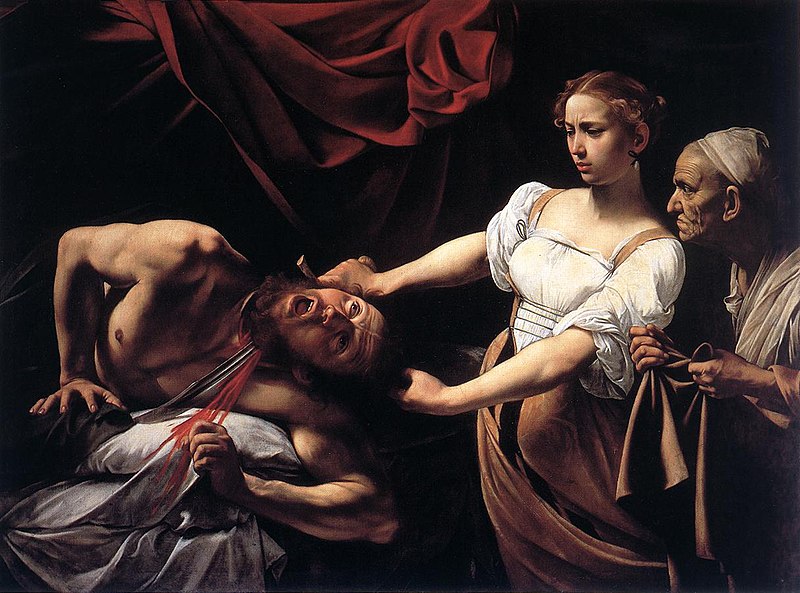

Caravaggio must have been a psychopath by our current standards, by the violence he perpetrated on other people, his truculunt life and suspicions of what we now name paedophilia.
His cupid (Amor vincit omnia) is not the idealized beautiful fair angel, rather a boy with a grin impertinent look, naughty kid.
When I think of Baroque I think of Rubens or Titian. Caravaggio seems too realist.
In the video dedicated to the Romantic Period, Delacroix is mentioned as a painter of the romanticism and many of his paintings are famous, to start with «La Liberté» the icon of the French Revolution
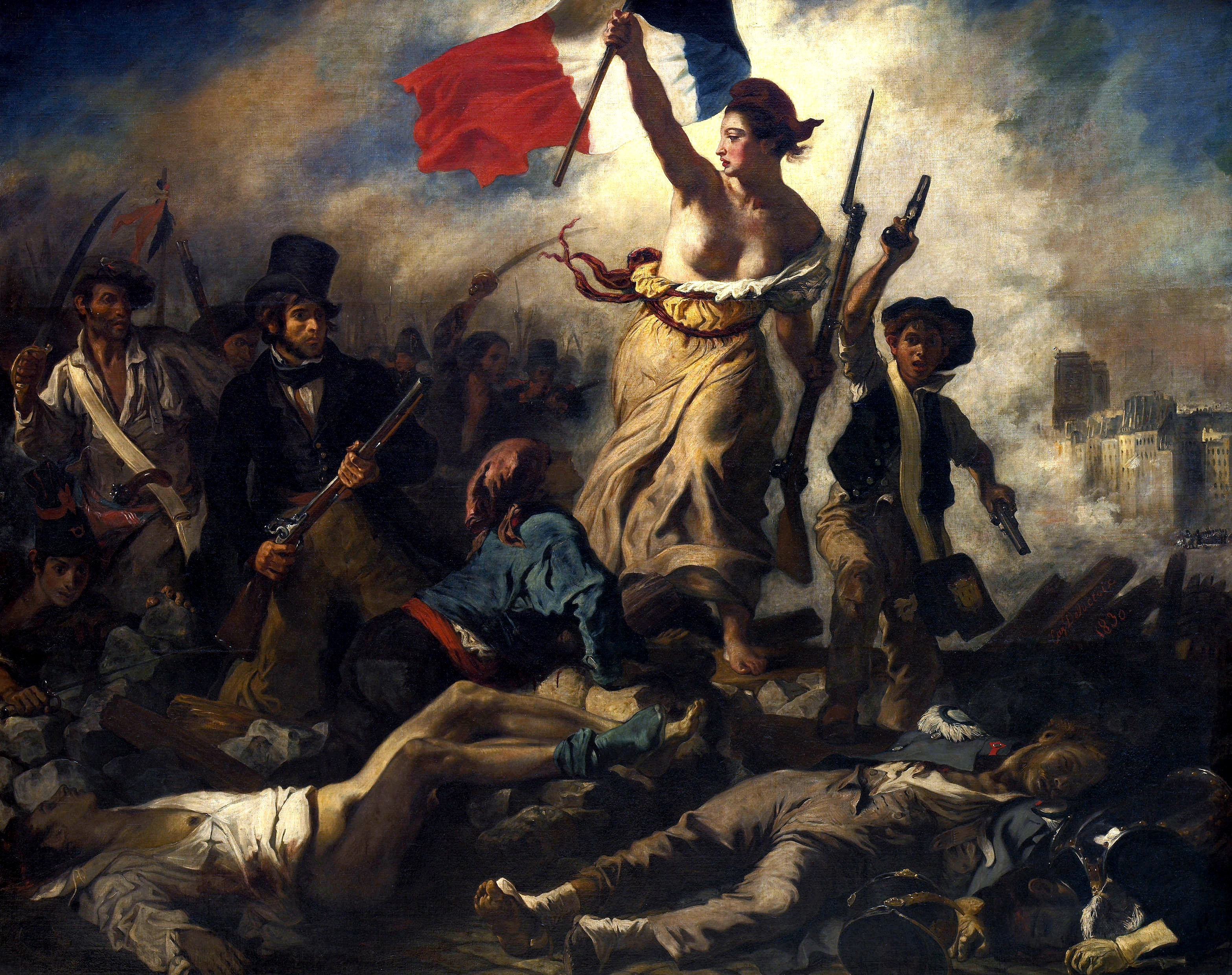
He traveled to North Africa and painted also exotic scenes

He was influenced by italian painters such as Rubens, and his paintings are full of movement and colour.
The paintings of his fellow contryman Gericault belong to the same family

However other romantic painters are quite distinct and their paintings have a personal trait, as is the case of Turner and the beautiful light of his landscapes

or Goya with the dark gloomy and dramatic famous painting The Third of May 1808

Khan Academy has good pages on Art, namely this one on French Romanticism – https://www.khanacademy.org/humanities/becoming-modern/romanticism/romanticism-in-france/a/romanticism-in-france
Culture has always been in crisis in Portugal and the national budget has always been poor. Nontheless as tourism has flourished i these last years, a great effort has been made to improve museums.
We have a great collection of carriages and the ancient museum had no place enough to display all, so a new modern museum was built, which took several years to be finished on account of lack of money.
It was built in the vicinity of the old building in a very beautiful area, by the river, where other museums and cultural sites are located.
The architectonic jewel of the neighbourhood is Belém Tower a XVI century monument that was set as a defense structure of the entry in the town and later on became a terrible prison.

The old building of the Coach Museum was in a royal palace which had beautiful painted ceilings, so some people found the new modern building too blank and cold.
I have visited it when it opened to the public and took some video clips with my mini tablet that I have edited in this video
To overcome the the lack of money museums have been financed by patrons to restore certains rooms of palaces and museums.
The most recent initiative was of crowdfunding led by the Museum of Ancient Art to acquire a classical painting to a private owner. It was surprising the way people supported the initiative and how fast they gathered the funding, About 15.000 individuals and 200 companies joined the effort which was great for our national scale

I forgot to mention another great portuguese female painter Maria Keil, whose master pieces remain in the public urban art. She designed many of the mosaic panels that inaugurated the first underground stations in Lisbon, in the 50’s


and a famous panel in an avenue in Lisbon – https://pt.wikipedia.org/wiki/Maria_Keil

We have this great tradition of mosaic art that dates back to the XVI century, with much influence from moorish tiles and later on to Flandres. Our underground stations have preserved this tradition in many of the recent stations. Old buildings in Lisbon (and other portuguese towns) have beautiful mosaic façades. I wish more recent buildings might use this artistic medium.
Some time ago I made this video with photos taken from the Internet about this great tradition of AZULEJO.
In the video on Realism are metioned some female painters and in fact it’s curious that so few female painters have projection along the centuries, if we compare to male painters.
There’s a famous portuguese female painter of the 17th century, Josefa d’Óbidos, who painted religious canvas, namely for churches

and more recent painters such as modernist Sara Afonso, who probably was outshadowed by her husband Almada Negreiros, one of the portuguese icons of modernism

Vieira da Silva is another great portuguese painter, who practically lived her life in Paris, in exile from Fascism. This is one of my favoutite paintings produced in the 70’s La Bibliotèque en Feu
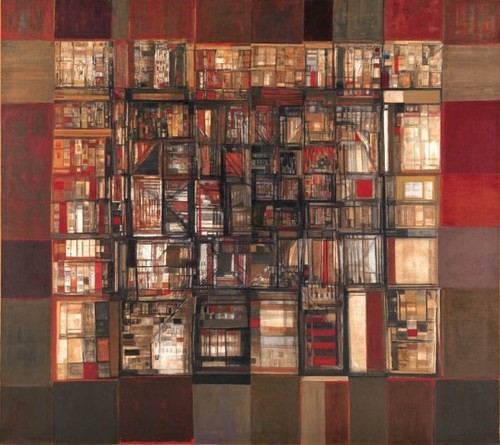
Contemporary Paula Rego, who has lived in London

and Graça Morais

First of all I wish to congratulate for the excellent videos and narratives of this course.
As I was listening to the videos, namely on Realism, I imediatelly related to our portuguese painter José Malhoa, who was born in late 19th century.

One of his paintings (1910) turned into an icon of portuguese art, though at the time it caused much criticism. It’s a sociological portrait of a marginal society. It’s called Fado, the national song, and depicts a prostitute and her pimp, a bully and criminal who spent more time in jail than in the open.

Malhoa paid the pimp Amâncio to serve as model at Adelaide’s home, a poor lodging in a typical and central neighbourhood of Lisbon – Mouraria (the name dates back to the time the Moors inhabited the region, 11th century). This neghbourhood has been associated with prostitution, up till recently. The Municipality put a great effort to regenerate it and now is a cross cultural area with chinese and indian communities.
Malhoa’s painting has a turbulent story, it seems Amâncio got jealous of the painter trying to paint Adelaide with less dress and threatened him with his knife. The painting took longer to finish because of frequent disagreements. Malhoa showed the painting to friends and took suggestions, namely to remove the tatoos of Adelaide, who had several, which was not usual at the time. Finally he shows the painting to his bourgeois friends and invites Amâncio and Adelaide as well. The painting was not well accepted in a conservative and provincial society but was acclaimed in foreign exhibitions.
This is a clip of an old film with Amália Rodrigues, the famous portuguese Fado singer, who sings a Fado dedicated to the painting, reproducing the scene of the painting.
Malhoa painted some other marginal scenes like the Drunken.



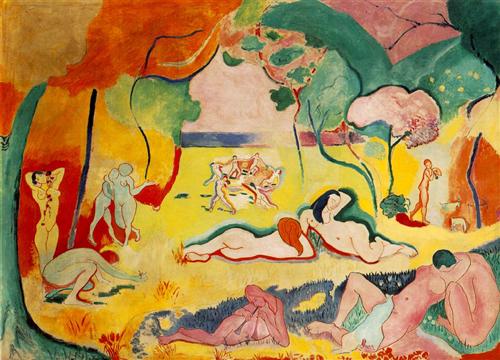
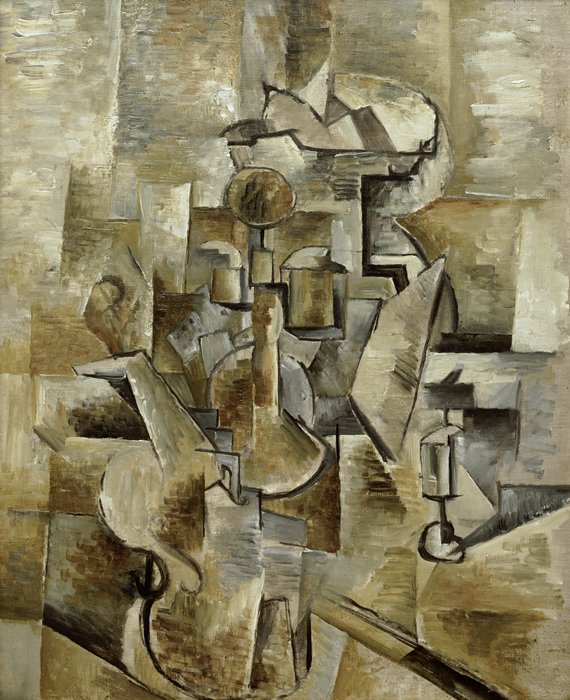




It is curious that many of the avant-garde artists like Kandinsky started painting «figurative» art, in his case, influenced by fauvism (strong strokes and strong colours). He starts the movement Blaue Reiter and evolves to pure abstract forms, aiming at a spiritual art that stimulates emotions. His theory of art is expressed
«”On the Spiritual In Art” (which was released in 1910) were both a defence and promotion of abstract art and an affirmation that all forms of art were equally capable of reaching a level of spirituality. He believed that colour could be used in a painting as something autonomous, apart from the visual description of an object or other form.» (https://en.wikipedia.org/wiki/Wassily_Kandinsky)
Oil on canvas – Tretyakov Gallery, Moscow» – http://www.theartstory.org/artist-kandinsky-wassily.htm
«Commonly cited as the pinnacle of Kandinsky’s pre-World War I achievement, Composition VII shows the artist’s rejection of pictorial representation through a swirling hurricane of colors and shapes. The operatic and tumultuous roiling of forms around the canvas exemplifies Kandinsky’s belief that painting could evoke sounds the way music called to mind certain colors and forms. Even the title, Composition VII, aligned with his interest in the intertwining of the musical with the visual and emphasized Kandinsky’s non-representational focus in this work. As the different colors and symbols spiral around each other, Kandinsky eliminated traditional references to depth and laid bare the different abstracted glyphs in order to communicate deeper themes and emotions common to all cultures and viewers.
Preoccupied by the theme of apocalypse and redemption throughout the 1910s, Kandinsky formally tied the whirling composition of the painting to the theme of the cyclical processes of destruction and salvation. Despite the seemingly non-objective nature of the work, Kandinsky maintained several symbolic references in this painting. Among the various forms that built Kandinsky’s visual vocabulary, he painted glyphs of boats with oars, mountains, and figures. However, he did not intend for viewers to read these symbols literally and instead imbued his paintings with multiple references to the Last Judgment, the Deluge, and the Garden of Eden, seemingly all at once.
Khan Academy presents na analysis ofthe painting – Improvisitions 28 (1913) – https://www.khanacademy.org/humanities/art-1010/early-abstraction/expressionism1/v/kandinsky-improv28
The russian revolution allowed the expression of original avant garde movements, in many cultural fields – poetry, theatre, sculpture, painting, film.
Those were years of an explosion of creativity that still impresses us today. I’ve always felt fascinated with this period and always recall the feeling of living those revolutionary days, reading John Reed’s «Ten Days that shook the World» (http://onlinebooks.library.upenn.edu/webbin/gutbook/lookup?num=3076).
Beyond the names that were mentioned in the session vídeo (Tatlin, El Lissitzky, Popova, etc) I always recall Mayakovsky his imponent figure and strong voice as described by William Carlos Williams – http://www.writing.upenn.edu/~afilreis/88v/wcw-auto.html
«I can’t remember all the names, but once, Mayakofsky, the Russian poet, appeared with his friend and manager who was wearing a particolored vest, half green and half white. Mayakofsky read aloud for us his “Willie the Havana Street Cleaner.” A big man, he rested one foot on top of the studio table as he read. It was the perfect gesture. He had a good voice, and though no one understood a word he said, we were all impressed by the tumbling sounds and his intense seriousness. I remember there were two giggling poets of the smarter and younger generation who, while thinking him wonderful, were more, as far as I could tell, impressed by his size than by anything else. Two nice little “girls.” For myself it sounded as might The Odyssey from the mouth of some impassioned Greek.»